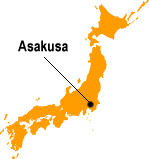

 |
||

|
A Bustling Street of Modern Times Dating
Back to the Edo Period
 As Tokyo's oldest temple town and also as a commercial district, Asakusa in Taito City, with the Senso-ji temple at its hub, has flourished ever since the Edo period (1603-1868). The walkway, called Nakamise, that runs from Senso-ji temple to Kaminarimon, its southern gate, is lined on both sides with souvenir stalls and evokes the atmosphere of old downtown Edo (present-day Tokyo) where merchants and artisans lived. This is also the site of various historical festivals such as Sanja Festival in May, Hozuki-ichi (Chinese Lantern Plant Fair) in July, and Toshi-no-ichi Fair in December. Sanja Festival held on the 17th and 18th of May is one of Tokyo's three largest festivals, and its historical origins trace back to the Kamakura period (1192-1338). July 10th, the Kannon Festival day (festival day for the Goddess of Mercy) is also the day of the Hozuki-ichi Fair, where many stalls are set up on the Senso-ji temple grounds to sell Chinese lantern plants. The Toshi-no-ichi Fair is held in late December and a variety of New Year's sundries and good-luck charms are on sale. Asakusa has been an amusement district since the Edo period, but particularly from the middle of the Meiji Era until just before the war, it flourished as Japan's most bustling entertainment area. It boasted some of Japan's most modern buildings including a landmark building popularly known as Asakusa 12-kai, a 52-meter (171-foot) brick observation tower that was Japan's tallest structure at that time, as well as an opera house. Japan's very first cinema was located here, and it was the site of popular culture offering opera, theatrical revues, light comedy, and vaudeville. Countless entertainers and actors made their start in Asakusa. Senso-ji temple as well as the entire Asakusa district was burned to the ground following the Great Kanto Earthquake in 1923 and again during the Second World War. After the war, both Senso-ji temple and Kaminarimon were restored. Although Asakusa did regain some of its former glory as a center for entertainment for a short period of time, young people gradually shifted their attention to new entertainment districts constructed near the major railway stations such as Shinjyuku or Shibuya. Currently, although Asakusa today does not retain much of its trend-setting past, it still attracts a throng of visitors who immerse themselves in that old downtown feeling. Photo: Kaminari-mon in Asakusa (Ministry of Foreign Affairs) Unauthorized reproduction of the
photos in this page is prohibited.
Related Links: |
|

